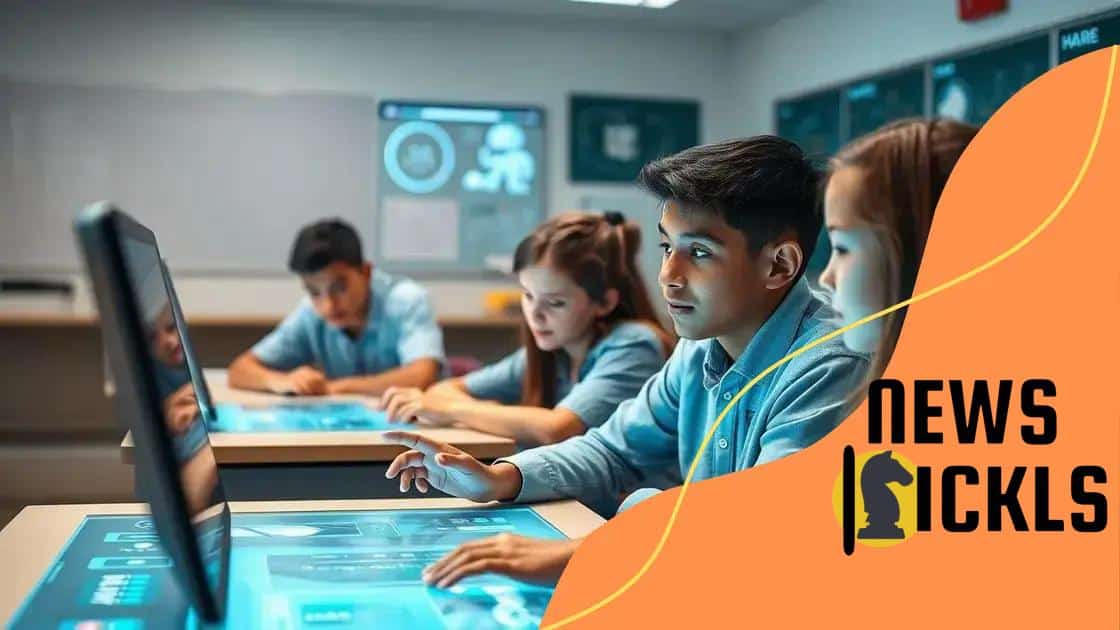How AI can help in identifying at-risk students in real-time

AI helps in identifying at-risk students in real-time by analyzing data to spot patterns, allowing educators to provide timely support and improve academic and emotional outcomes.
How AI can help in identifying at-risk students in real-time is becoming a vital conversation for educators. Imagine having a tool that informs teachers about students who might need extra help before it’s too late. This article delves into how AI can change the landscape of student support.
Understanding the challenges of identifying at-risk students
Identifying at-risk students is a critical challenge faced by educators today. Understanding the specific barriers that these students encounter can significantly improve their chances of success. Let’s explore the issues surrounding the identification of at-risk students.
Common Challenges
Schools often grapple with various significant challenges when trying to identify at-risk students. Factors such as attendance, academic performance, and social-emotional well-being can complicate assessments. Each student’s situation is unique, making it essential to adopt a comprehensive view.
- Incomplete records: Missing data on student backgrounds can obscure their needs.
- Early warning signs: Educators may overlook subtle indications of distress.
- Resource limitations: Schools might lack sufficient tools to analyze student data effectively.
- Bias in assessments: Cultural factors can influence how educators perceive and evaluate students.
Moreover, teachers often find it difficult to maintain communication about these students. With a large number of students to monitor, identifying those who require additional support can easily slip through the cracks. These circumstances make it essential for educators to focus on their students’ overall circumstances rather than solely on academic results.
The Importance of Collaboration
Collaboration among faculty, counselors, and administration is vital to understanding each student’s unique needs. Sharing insights can help in spotting patterns that one educator alone might miss. By working together, schools can develop more effective strategies and implement timely interventions.
It’s also important to utilize technology. Digital tools can assist in managing data and highlighting at-risk behaviors in real-time. Thus, harnessing analytics can streamline the identification process. Questions like, “How can we work together to spot students in trouble?” can lead to proactive measures.
Ultimately, bridging the gap in identifying at-risk students requires a multifaceted approach, where collaboration and technology play pivotal roles.
How real-time data analytics works in education
Real-time data analytics is transforming the educational landscape. By collecting and analyzing data as it happens, schools can gain valuable insights into student performance and behavior. This approach helps educators make informed decisions quickly.
How it Works
Real-time data analytics employs various tools and software to track student progress. For example, data can be gathered from assessments, attendance records, and even behavioral reports. With this information, schools can identify trends and patterns effectively.
- Data collection: Information is continuously gathered from multiple sources.
- Instant reporting: Educators receive immediate feedback on student performance.
- Predictive analytics: Schools can forecast which students might struggle based on historical data.
- Customized strategies: Insights allow for tailored interventions for each student.
This approach enables teachers to act swiftly when they notice a student falling behind. For instance, if a student’s grades dip after a series of quizzes, the system can flag this red flag and notify educators. This allows for immediate support before issues worsen.
Benefits of Real-Time Analytics
The advantages of using real-time data analytics in education are significant. Schools can enhance learning outcomes by adapting teaching methods based on up-to-date information. It fosters a proactive rather than reactive environment, where educators can anticipate challenges and act accordingly.
Moreover, parents can also benefit from this real-time monitoring. Teachers can share insights with them, ensuring they stay informed about their child’s progress. This partnership helps reinforce support at home and in school.
Lastly, as technology continues to evolve, the potential for real-time analytics in education will expand. With increased resources, educators can further refine their approaches to meet the unique needs of each student.
Case studies of AI applications in schools

Case studies of AI applications in schools provide valuable insights into how this technology positively impacts education. Various schools across different regions have successfully implemented AI solutions to enhance learning experiences and identify at-risk students.
Notable Examples
One compelling case comes from a school district that utilized AI-driven tools for personalized learning. By analyzing student data, teachers could tailor lessons to meet each student’s needs. This approach led to significant improvements in engagement and study habits.
- Personalized Learning: Students received targeted resources based on their strengths and weaknesses.
- Attendance Tracking: AI systems identified patterns of absenteeism, prompting interventions.
- Behavior Monitoring: Schools detected potential behavioral issues through patterns in student interactions.
- Resource Allocation: AI helped administrators allocate resources effectively based on real needs.
Another unique example is seen in a pilot program where AI-chatbots were used to support students outside of school hours. These chatbots provided homework help and answered common questions, helping students feel more supported and connected to their learning.
Impact on Educators
The integration of AI in schools does not only benefit students; it also supports educators. With AI handling routine tasks, teachers can focus on what matters most—teaching. For instance, an AI system that grades assignments allows teachers to spend more time on lesson planning and individual student interactions.
Moreover, AI solutions provide teachers with actionable insights about student performance. This data can guide curriculum adjustments and improve overall classroom dynamics. Schools that have embraced these technologies often report a more collaborative and effective teaching environment, fostering innovation in educational practices.
Ultimately, these case studies highlight the transformative potential of AI in education. As schools continue to embrace technology, the scope of its applications will undoubtedly expand, paving the way for better student outcomes.
Benefits of early intervention through AI insights
The benefits of early intervention through AI insights are profound. By recognizing at-risk students early, educators can implement supportive measures tailored to individual needs. This proactive approach fosters a stronger foundation for student success.
Key Advantages
When schools leverage AI to identify students in need, they can gain several advantages that directly impact learning outcomes. For example, timely interventions can prevent small issues from escalating into significant barriers to success.
- Improved Academic Performance: Early support can lead to better grades and understanding of the material.
- Enhanced Student Engagement: Students who receive timely help often feel more connected to their education.
- Emotional Support: Addressing challenges early can help build resilience and improve mental health.
- Parental Involvement: Early alerts can encourage parents to engage more actively in their child’s education.
Moreover, AI tools can analyze data trends and suggest targeted strategies for intervention. Educators who utilize AI can adjust teaching methods based on specific student needs, creating more personalized learning experiences. This adaptability helps students thrive in a supportive environment.
Long-Term Benefits
By acting early, schools can positively influence long-term outcomes for students. For instance, students who receive help early in their academic journey are less likely to drop out or face long-term educational challenges. Additionally, early interventions often lead to improved social skills and learning behaviors.
Ultimately, the insights provided by AI equip educators with the knowledge to make informed decisions. This means that every student has a chance to succeed, regardless of the obstacles they face. By prioritizing early intervention, schools can create a more equitable educational landscape for all students.
Future trends in AI and student support
Future trends in AI and student support promise exciting developments in education. As technology advances, AI will play an even more significant role in enhancing learning experiences and improving student outcomes.
Emerging AI Technologies
One of the key trends is the advancement of machine learning algorithms. These algorithms will become more sophisticated in analyzing student data to predict academic success and identify those at risk of falling behind. As these technologies evolve, they will provide deeper insights into student behavior and performance.
- Adaptive Learning Systems: These systems will tailor educational content to individual learning styles and paces, ensuring that each student receives personalized instruction.
- AI Tutoring Systems: Virtual tutors powered by AI will offer 24/7 assistance, helping students with homework and concepts they find challenging.
- Data-Driven Decision Making: Schools will increasingly rely on data analytics to inform teaching strategies and interventions.
- Enhanced Collaboration Tools: Innovative platforms will facilitate better communication between teachers, students, and parents.
Moreover, the integration of AI with other technologies such as virtual reality (VR) and augmented reality (AR) will create immersive learning experiences. For example, students may explore historical sites or scientific phenomena in a virtual setting, making learning more engaging and effective.
Focus on Mental Health
Another important aspect of future trends is the increasing focus on mental health. AI can help monitor student well-being by analyzing data from social interactions and performance metrics. Schools will have tools to identify changes in behavior that might indicate mental health issues, allowing for timely support.
Furthermore, AI-driven platforms may provide resources for mindfulness and stress relief, helping students manage their emotional health effectively. By fostering a supportive environment, schools can enhance the overall learning experience.
As AI continues to evolve, it will not only support academic success but also promote holistic development for students. The combination of advanced technology and a focus on well-being will shape the future of education.
FAQ – Frequently Asked Questions about AI in Education
How does AI help identify at-risk students?
AI analyzes student data in real-time, spotting patterns that indicate students may require additional support.
What are the benefits of early intervention using AI?
Early intervention can significantly improve academic outcomes and emotional health by providing timely support tailored to individual student needs.
Can AI technology enhance teacher-student communication?
Yes, AI tools facilitate seamless communication between teachers, students, and parents, ensuring everyone stays informed about progress.
What future trends should we expect in AI and education?
Expect advancements in adaptive learning systems, AI tutoring, and a greater focus on students’ mental health and well-being through technology.






